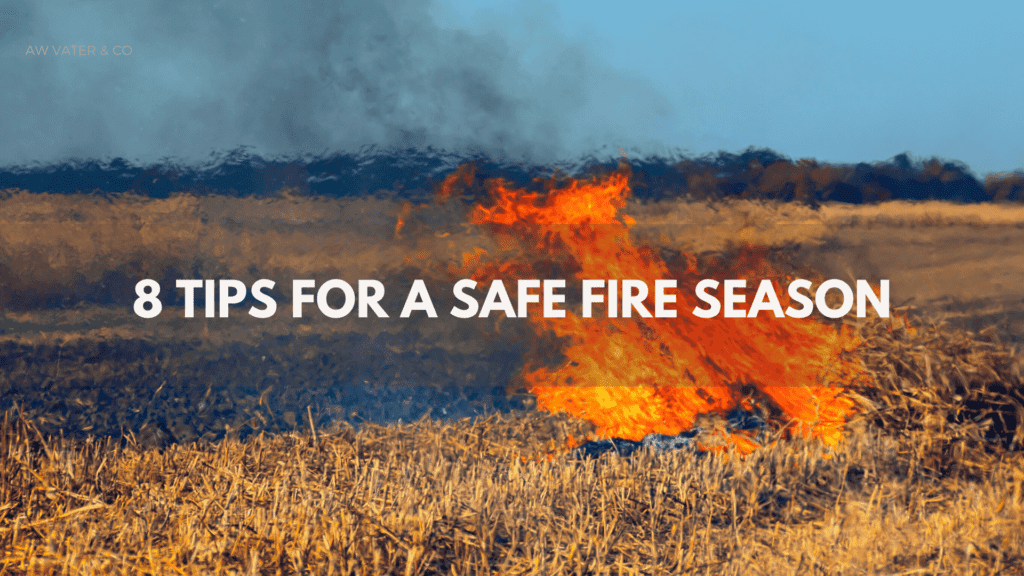Your checklist to be ready and safe this fire season.
The current fire ban season is from the 1st of November 2023 to the 30th of April 2024 for both the Mid-North and Yorke Peninsula.
Here’s a quick checklist of 8 things you can do to keep your farm and property safe and ready. But always check the CFS website for the best and most reliable information.
1. Have your fire equipment ready to go.
- Check your fire unit and pumps, start them and have them ready to go. Check fuel and oil levels and have water in the tank. Do a test run to ensure nozzles aren’t blocked, and everything is working correctly.
- Register your ute as FFU if you need – click here.
- Come see us if you need help updating any:
- Fire units
- Pumps
- Tanks
- Reels
- Hoses
- Nozzles
- Safety gear
- Have a backup safety kit ready and in the ute. Good inclusions are goggles, leather gloves, P2 masks, woollen blankets, a torch, radio, and protective clothing.
2. Have a plan.
Chances are, by living in rural Australia, you may experience a dangerous bushfire at some time in your life. Apart from preparing your home and property, one of the most important things you can do is to decide what you’ll do in case of a fire. So, if you haven’t already, now is the time to prepare your property and start your plan.
- Be prepared to leave, and have your whole family be able to answer:
- Where would we go
- What would we take
- Know to tell people when you’re leaving
- Know to leave straight away with plenty of time > Don’t leave it to the last minute.
- Have a plan for your pets.
- Practise your Bushfire Survival Plan with your family, and ensure you have a portable battery-powered radio and spare batteries to listen to bushfire warnings.
If you need to make a plan, check out the CFS website here.
3. Be organised – especially over harvest or anytime in the paddock.
On the farm:
- Adhere to CFS and council guidelines.
- Check the CFS website for farm fire safety and prevention: https://www.cfs.sa.gov.au/plan-prepare/business-farms/farm-fire-safety-prevention/
- Always carry a minimum of 250 litres of water in the firefighter in the paddock when reaping or loading grain.
- Carry a shovel or rake with your fire unit.
- Prepare an emergency fire kit for the ute, including any safety equipment and PPE gear.
- Ensure all vehicles and machines are in good working order, regularly check your exhaust systems, and remove any buildup of flammable material caught in the vehicle’s exhaust pipe, muffler or catalytic converter.
- Restrict off-road driving to tracks where the grass is low and park only in cleared areas, and where possible, avoid driving a vehicle across paddocks of long dry grass or crop stubble.
- Ensure your UHF, AM radio, and mobile phones are in good condition and working.
Around the home:
- Check the CFS website here: https://www.cfs.sa.gov.au/plan-prepare/before-a-fire-be-prepared/preparing-your-home-property/
- Make sure there is enough space for fire trucks to get in and turn around on your property.
- Pack an emergency kit with essential items and documents, and keep it in a handy, easy-to-find spot.
- Make a list of and scan important documents and photos onto a USB stick / external drive.
- Have a battery-operated radio, powerful torch and extra batteries.
- Set aside protective clothing (long-sleeved, made from natural material such as cotton, sturdy footwear such as leather boots and a P2 mask) for each member of the family.
- Put woollen blankets in your car – just in case you get caught on the road.
- Mark your main routes, including backup routes and petrol stations on hard-copy maps.
- Don’t forget pets – make sure your pet’s needs are in your emergency kit or packed in the car.
4. Have a clear house and farm yard.
A clean, well-organised property reduces fire risk and the likelihood of fire spreading and makes it easy for you or firefighters to defend.
- Water your lawns, trees and shrubs near the house to keep them green.
- Check around the house – screens, clear away debris, and block any areas where embers could enter into or under your home.
- Maintain a defendable space of up to 20 metres around your home and 5 metres from sheds and garages.
- Prepare your garden areas by removing dead branches, leaves, and undergrowth and pruning tree limbs lower than 2m from ground level.
- Clear around trees and prune dead material around the home, in your yard and around sheds.
- Keep removing leaves and debris from gutters and the roof.
- Slash stubble near sheds and buildings (preferably in spring and by following regulations for Total Fire Ban Days), or if you have livestock, keep grazing pressure high in areas near the house.
- Move woodpiles and stacked timber away from the house.
- Invest in protective measures around the home, such as bushfire downpipe plugs or a bushfire sprinkler system.
- Around the house, prepare a sturdy hose with metal fittings that will reach all around your home.
5. Ensure you’ve got a reliable water supply on farm.
- Check reserve water supplies.
- Check hoses for leaks, and ensure there isn’t any algae or slime buildup in your tanks.
- Have a reliable, independent water supply of at least 5000 litres over summer. Tanks, dams or swimming pools will do the trick.
6. Know where to stay updated.
- Follow the CFS code of conduct for reaping on those hot, windy days, which can be found on the CFS website.
- Keep an eye on local conditions – stay up to date with where fires are located by using the SA Fires app, the CFS website, or listening to the ABC radio station. Social media can also be used: Facebook: @Countryfireservice, Twitter: @CFSalerts.
7. Talk to your neighbours!
Talk to neighbours or nearby friends about ways you can help each other out, what roads can be used, and where the nearest safe zones are.
8. Know what you can and can’t do during fire danger season and on total fire ban days.
Can you have a BBQ? What about a pizza oven? Are you allowed to use an angle grinder? The CFS has this covered in a great list, which can be found here.
Please note: We’ve written this article regarding households and properties in general and not regarding grain harvesting.
For more information on grain harvesting, check out the CFS website or: grdc.com.au
We’ve accessed this information from the CFS Website. Head on over for more great resources: cfs.sa.gov.au
Think you’ve got it covered? Test yourself with the CFS’s household self-assessment tool.

